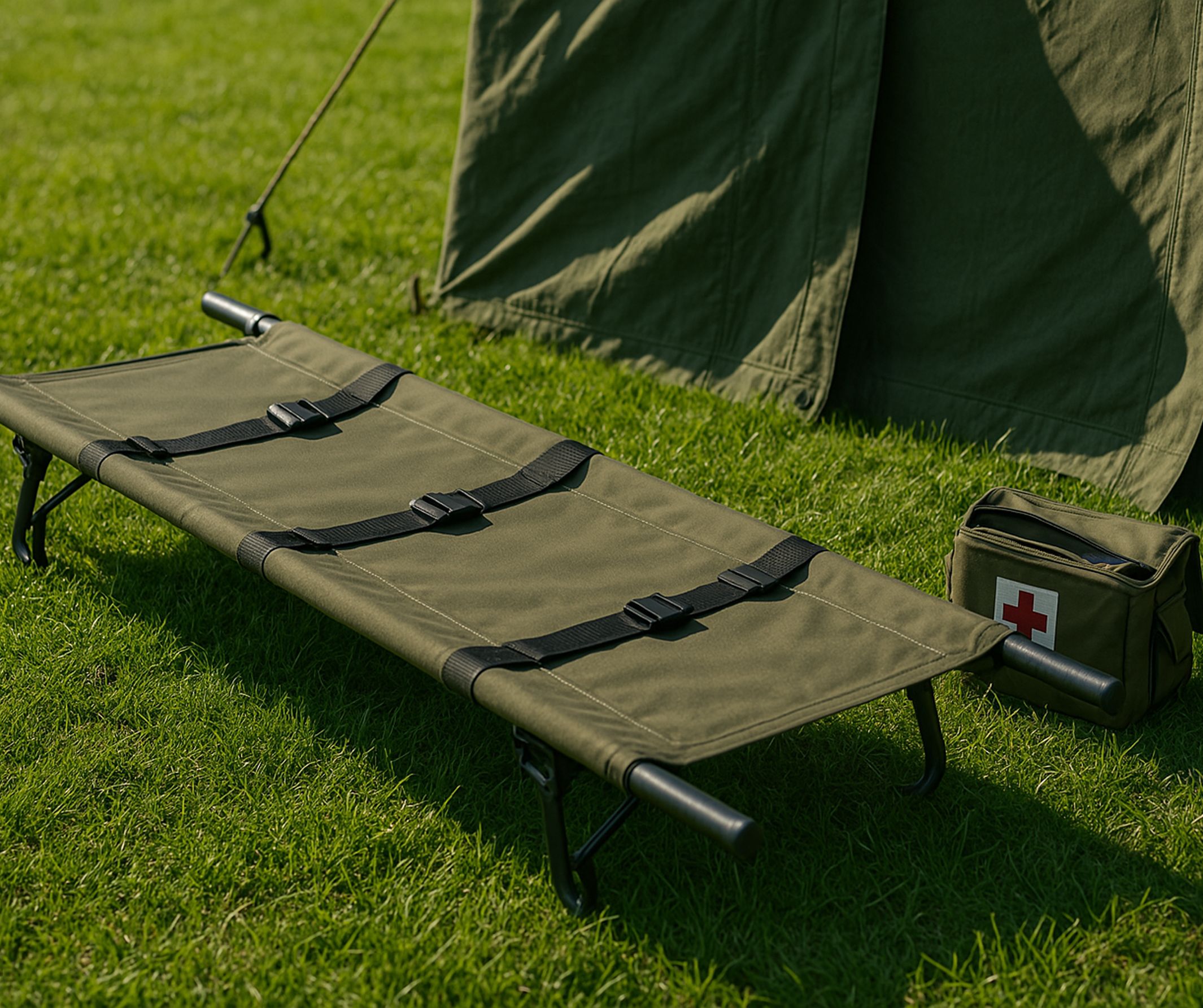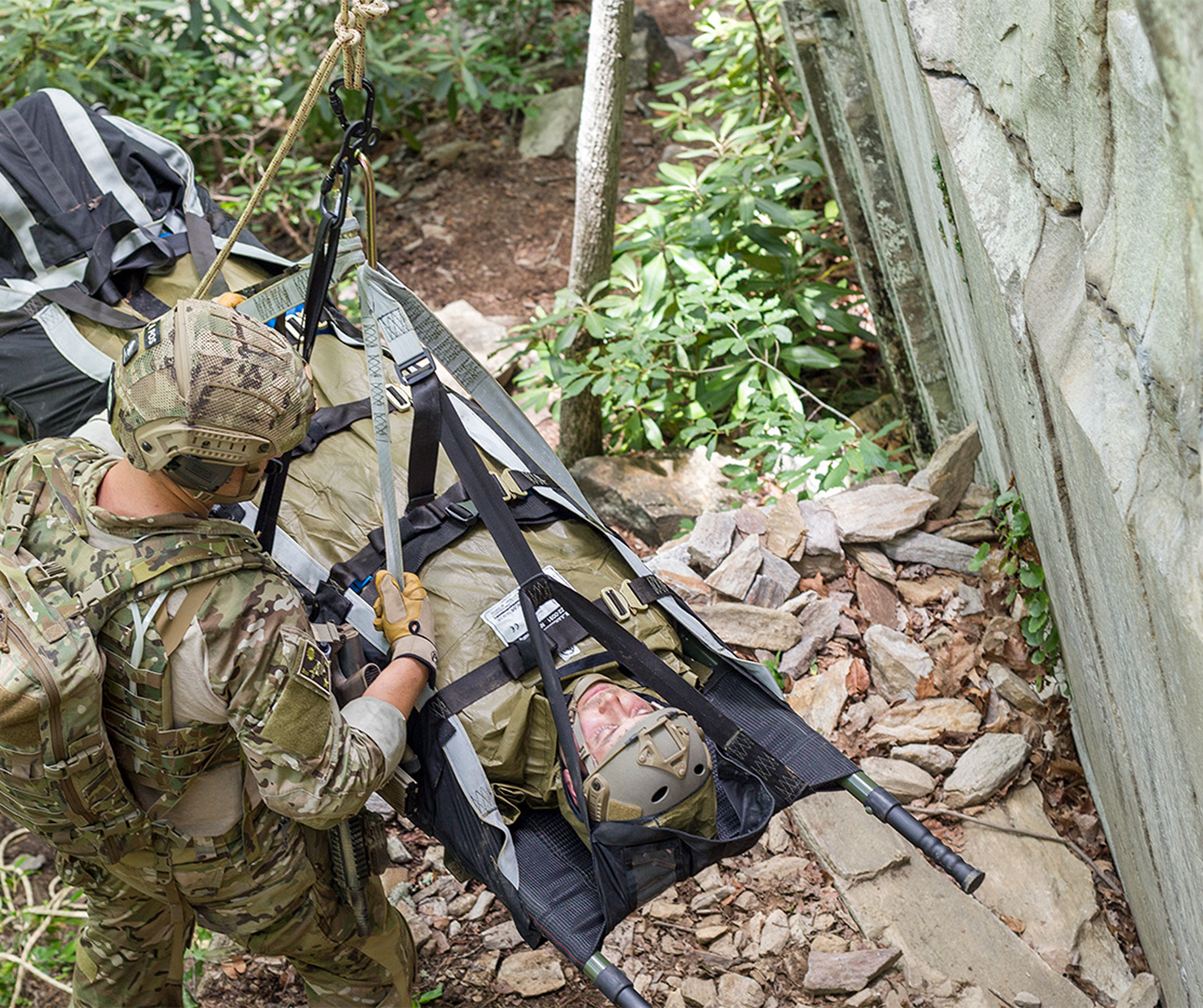Durable, lightweight materials for
stretchers, tents, shelters, and field equipment
Harsh conditions demand dependable gear
Military operations and emergency response scenarios often unfold in extreme environments, where equipment failure can endanger lives. Stretchers must support the full weight of a wounded individual, sometimes while being carried over rough terrain or hoisted into aircraft. If the fabric rips or degrades under strain, rescuers face serious safety hazards and potential mission failures. Continuous exposure to mud, water, intense UV rays, and chemicals further challenges materials that are already under high tension.
Harsh conditions demand dependable gear
Military operations and emergency response scenarios often unfold in extreme environments, where equipment failure can endanger lives. Stretchers must support the full weight of a wounded individual, sometimes while being carried over rough terrain or hoisted into aircraft. If the fabric rips or degrades under strain, rescuers face serious safety hazards and potential mission failures. Continuous exposure to mud, water, intense UV rays, and chemicals further challenges materials that are already under high tension.
Harsh conditions demand dependable gear
Military operations and emergency response scenarios often unfold in extreme environments, where equipment failure can endanger lives. Stretchers must support the full weight of a wounded individual, sometimes while being carried over rough terrain or hoisted into aircraft. If the fabric rips or degrades under strain, rescuers face serious safety hazards and potential mission failures. Continuous exposure to mud, water, intense UV rays, and chemicals further challenges materials that are already under high tension.
.jpeg)
.jpeg)

.jpeg)
.jpeg)


Beyond stretchers, tents and temporary barriers are similarly at risk of tearing or rotting if made from low-quality textiles. When a tent rips in high winds or in hot, humid climates, it jeopardizes soldiers’ or responders’ ability to rest, protect equipment, or store supplies. Managing these pitfalls in real time can escalate both logistical burden and overall risk.
Reliable gear supports mission success and saves lives

Strong, lightweight fabrics empower military and rescue teams to navigate difficult scenarios with greater confidence. A properly built litter lets personnel transport the injured efficiently, minimizing pain and chance of further harm. Equipment that resists moisture and tears extends the window of safe operation, whether it is a tent protecting crucial medical supplies or a barrier blocking debris.
Mission efficiency also improves when gear can be deployed rapidly without frequent repairs. Stretchers and tents that remain intact under stress reduce the need for backup units or last-minute fixes, preserving resources for other mission-critical tasks. Durable fabrics ultimately contribute to morale by ensuring that conditions in the field are not worsened by equipment failures.
Harsh conditions demand dependable gear
Military operations and emergency response scenarios often unfold in extreme environments, where equipment failure can endanger lives. Stretchers must support the full weight of a wounded individual, sometimes while being carried over rough terrain or hoisted into aircraft. If the fabric rips or degrades under strain, rescuers face serious safety hazards and potential mission failures. Continuous exposure to mud, water, intense UV rays, and chemicals further challenges materials that are already under high tension.
Reliable gear supports mission success and saves lives
Strong, lightweight fabrics empower military and rescue teams to navigate difficult scenarios with greater confidence. A properly built litter lets personnel transport the injured efficiently, minimizing pain and chance of further harm. Equipment that resists moisture and tears extends the window of safe operation, whether it is a tent protecting crucial medical supplies or a barrier blocking debris.
Mission efficiency also improves when gear can be deployed rapidly without frequent repairs. Stretchers and tents that remain intact under stress reduce the need for backup units or last-minute fixes, preserving resources for other mission-critical tasks. Durable fabrics ultimately contribute to morale by ensuring that conditions in the field are not worsened by equipment failures.

.jpeg)
.jpeg)

.jpeg)
.jpeg)
.jpeg)
.jpeg)
.jpeg)

How NICOLON fabrics meet military-grade standards
NICOLON fabrics incorporate high-tensile yarns treated to resist UV damage, rot, and chemicals. They’re produced under stringent quality controls to deliver consistent performance, an essential requirement in military supply chains. For stretchers, the fabric’s lightweight nature eases transport while still offering enough structural integrity to handle the weight of an injured soldier. Crews can fold or roll the material for compact storage without worrying about permanent creases or compromised strength.
Tents and shade structures made from NICOLON fabrics also benefit from water and air permeability, allowing ventilation while keeping out rain or wind-driven sand. This breathable design helps regulate temperature inside the shelter. In long-term deployments, the fabric’s flame-retardant option further boosts safety, reducing fire risks in camps or field hospitals. Because NICOLON is chemically inert, it doesn’t corrode or weaken when exposed to disinfectants or fuel spills. Over multiple tours, the fabric remains tough, reaffirming its reputation as a go-to for mission-critical gear.NICOLON fabrics incorporate high-tensile yarns treated to resist UV damage, rot, and chemicals. They’re produced under stringent quality controls to deliver consistent performance, an essential requirement in military supply chains. For stretchers, the fabric’s lightweight nature eases transport while still offering enough structural integrity to handle the weight of an injured soldier. Crews can fold or roll the material for compact storage without worrying about permanent creases or compromised strength.
Tents and shade structures made from NICOLON fabrics also benefit from water and air permeability, allowing ventilation while keeping out rain or wind-driven sand. This breathable design helps regulate temperature inside the shelter. In long-term deployments, the fabric’s flame-retardant option further boosts safety, reducing fire risks in camps or field hospitals. Because NICOLON is chemically inert, it doesn’t corrode or weaken when exposed to disinfectants or fuel spills. Over multiple tours, the fabric remains tough, reaffirming its reputation as a go-to for mission-critical gear.




Key benefits
High tensile strength
Withstands heavy loads for stretchers and other field equipment
Rot and mildew resistance
Maintains integrity in wet or humid conditions
UV protection
Minimizes degradation from constant sun exposure
Chemical resistance
Endures contact with disinfectants and fuels
Breathable yet water-repellent
Suitable for tents, shade nets, and protective barriers
Lightweight portability
Simplifies transport and deployment in challenging terrain
Resources
Heading 3
Heading 3

.png)





